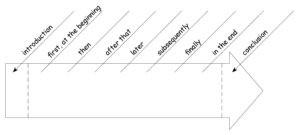
a) The instructor draws (or projects) a timeline (a long arrow; see above) on the board, and explains to the class that it will help them understand how to clearly structure a text.
b) For visualization purposes and clarity, the class will go through a detailed example. A theme with a clear series of events should be chosen, for example: “My summer vacation”, “Last weekend”, “The life of mother Theresa”. Descriptive or reflective topics, such as “My thoughts about Peace”, etc., are less suitable for this method (see the following three-part scheme).
c) The instructor works with the class in deciding and marking which words and phrases are most suitable for structuring and marking different subsequent steps in a text: “At the beginning, then, after that, thereafter, the next day, finally, in the end” etc. This exercise also serves to help students build up an appropriate vocabulary in the heritage language.
d) The students receive a simple action-oriented topic (e. g. “My daily routine”) and A3 paper. On this they draw a timeline and write down the different parts of the action. The pages are then reviewed and discussed by the class as a whole.
e) Finally, the students write their text in prose, thereby orienting themselves on the stages of the timeline.






